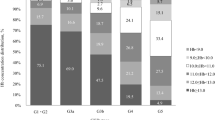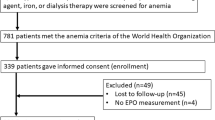Abstract
We investigated erythropoietin (Epo) response in a cohort of diabetic patients with various types of anemia to approach the pathogenesis of some cases of “unexplained” anemia encountered among diabetics. Serum Epo levels were determined totally in 747 evaluable subjects with normal renal and hepatic function, of whom 694 had anemia. Among anemic patients, 237 were diabetics, while among the 53 nonanemic persons, there were also 21 diabetics. Diabetic and nondiabetic subjects were uniformly balanced in relation to their demographic features and were categorized according to the etiology of their anemia. Hemoglobin (Hb) did not differ between diabetic and nondiabetic subjects in all the etiological groups and in the whole population. Diabetic patients had significantly lower serum Epo levels as compared to nondiabetics (36.5±61 vs 69.4±191 IU/ml, p<0.0001), and this was true for all etiologic groups of anemia with the exception of patients with myeloproliferative disorders and those with megaloblastic anemia. The natural logarithmic (ln)–Epo×Hb component was used as an index of response to anemia and was found to be significantly decreased in almost all subgroups of diabetic patients. Serum Epo levels were also negatively correlated with the percentage of glycosylated Hb, HbA1C (r=−0.446), and the correlation was stronger with the ln of serum Epo (r=−0.638, p<0.001). Inappropriately low serum Epo level is a uniform feature in patients with type II diabetes mellitus and may represent a constitutive blunted response to anemia or an altered metabolic rate of Epo, probably as a result of abnormal glycosylation of the cytokine.


Similar content being viewed by others
References
Symeonidis A, Psiroyannis A, Kyriazopoulou V, Kapatais-Zoumbos K, Missirlis Y, Zoumbos N (2001) Impairment of erythrocyte viscoelasticity is correlated with levels of glycosylated haemoglobin in diabetic patients. Clin Lab Haematol 23:103–109
Stevens PE, O’Donogue DJ, Lameire NR (2003) Anemia in patients with diabetes: unrecognized, undetected and untreated? Curr Med Res Opin 19:395–401
Smith DM, Norton JA, Roberts SD, Maxey WA, McDonald CJ (1983) Unexpected hospital admissions among patients with diabetes mellitus. Arch Intern Med 143:41–47
de Klerk G, Rosengarten PC, Vet RJ, Goudsmit R (1981) Serum erythropoietin (EST) titers in anemia. Blood 58:1164–1170
Urabe A, Saito T, Fukamachi H, Kubota M, Takaku F (1987) Serum erythropoietin titers in the anemia of chronic renal failure and other hematological states. Int J Cell Cloning 5:202–208
Baer AN, Dessypris EN, Goldwasser E, Krantz SB (1987) Blunted erythropoietin response to anaemia in rheumatoid arthritis. Br J Haematol 66:559–564
Miller CB, Jones RJ, Piantadosi S, Abeloff MD, Spivak JL (1990) Decreased erythropoietin response in patients with the anemia of cancer. N Engl J Med 322:1689–1692
Bosman DR, Winkler AS, Marsden JT, McDougall IC, Watkins PJ (2001) Anemia with erythropoietin deficiency occurs early in diabetic nephropathy. Diabetes Care 24:495–499
Hadjadj S, Torremocha F, Fanelli A, Brizard A, Baues M, Marechaud R (2001) Erythropoietin-dependent anemia: a possible complication of diabetic neuropathy. Diabetes Metab 27:383–385
Winkler AS, Marsden J, Chaudhuri KR, Hambley H, Watkins PJ (1999) Erythropoietin depletion and anaemia in diabetes mellitus. Diabet Med 16:813–819
Inomata S, Itoh M, Imai H, Sato T (1997) Serum levels of erythropoietin as a novel marker reflecting the severity of diabetic nephropathy. Nephron 75:426–430
Kojima K, Totsuka Y (1995) Anemia due to reduced serum erythropoietin concentration in non-uremic diabetic patients. Diabetes Res Clin Pract 27:229–233
Ricerca BM, Todaro I, Caputo S et al (1999) Blunted erythropoietin response to anemia in patients with type 1 diabetic patients. Diabetes Care 22:647
Cotroneo P, Maria Ricerca B, Todaro L et al (2000) Blunted erythropoietin response to anemia in patients with type 1 diabetes. Diabetes Metab Res Rev 16:172–176
Yun YS, Lee HC, Yoo NC et al (1999) Reduced erythropoietin responsiveness to anemia in diabetic patients before advanced diabetic nephropathy. Diabetes Res Clin Pract 46:223–229
Craig KJ, Williams JD, Riley SG et al (2005) Anemia and diabetes in the absence of nephropathy. Diabetes Care 28:1118–1123
Ihimura E, Nishizawa Y, Okuno S et al (1998) Diabetes mellitus increases the severity of anemia in non-dialyzed patients with renal failure. J Nephrol 11:88–91
Rush RS, Derby PL, Smith DM et al (1995) Micro-heterogeneity of erythropoietin carbohydrate structure. Anal Chem 67:1442–1452
Misaizu T, Matsuki S, Strickland WT, Takeuchi M, Kobata A, Takasaki S (1995) Role of antennary structure of N-linked sugar chains in renal handling of recombinant human erythropoietin. Blood 86:4097–4104
Rahbek-Nielsen H, Roepstorff P, Reischl H, Wozny M, Koll H, Haselbeck A (1997) Glycopeptide profiling of human urinary erythropoietin by matrix-assisted laser desorption/ionization mass spectrometry. J Mass Spectrom 32:948–958
Guthrow EC, Morris MA, Day JF, Thorpe SR, Baynes JW (1979) Enhanced non-ezymatic glycosylation of human serum albumin in diabetes mellitus. Proc Natl Acad Sci U S A 76:4258–4261
Watala C (1992) Hyperglycemia alters the physicochemical properties of proteins in erythrocyte membranes of diabetic patients. Int J Biochem 24:1755–1761
Bosman DR, Osborne CA, Marsdent JT, Macdougall IC, Gardner WN, Watkins PJ (2002) Erythropoietin response to hypoxia in patients with diabetic autonomic neuropathy and non-diabetic chronic renal failure. Diabet Med 19:65–69
Dikow R, Schwenger V, Schömig M, Ritz E (2002) How should we manage anemia in patients with diabetes? Nephrol Dial Transplant 17(Suppl 1):67–72
Rigalleau V, Blanchetier V, Aparichio M et al (1998) Erythropoietin can deteriorate glucose control in uremic non-insulin dependent diabetic patients. Diabetes Metab 24:62–65
Author information
Authors and Affiliations
Corresponding author
Rights and permissions
About this article
Cite this article
Symeonidis, A., Kouraklis-Symeonidis, A., Psiroyiannis, A. et al. Inappropriately low erythropoietin response for the degree of anemia in patients with noninsulin-dependent diabetes mellitus. Ann Hematol 85, 79–85 (2006). https://doi.org/10.1007/s00277-005-1102-9
Received:
Accepted:
Published:
Issue Date:
DOI: https://doi.org/10.1007/s00277-005-1102-9




